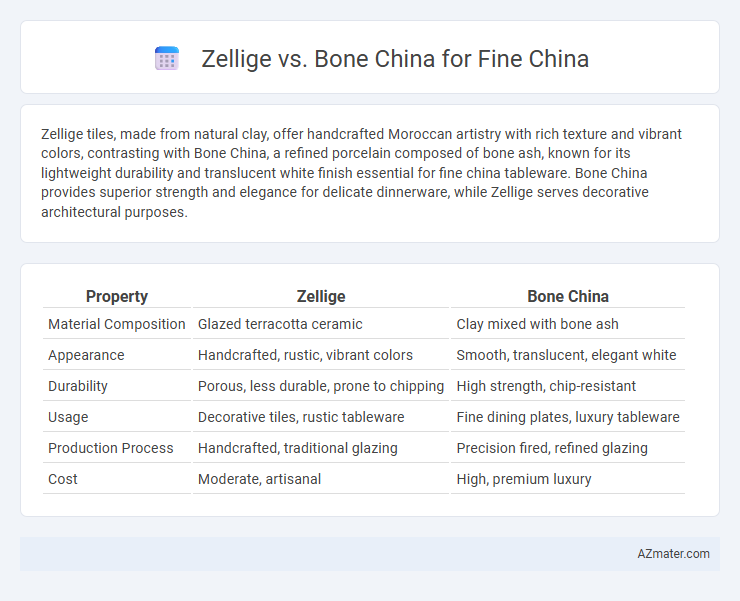Zellige tiles, made from natural clay, offer handcrafted Moroccan artistry with rich texture and vibrant colors, contrasting with Bone China, a refined porcelain composed of bone ash, known for its lightweight durability and translucent white finish essential for fine china tableware. Bone China provides superior strength and elegance for delicate dinnerware, while Zellige serves decorative architectural purposes.
Table of Comparison
| Property | Zellige | Bone China |
|---|---|---|
| Material Composition | Glazed terracotta ceramic | Clay mixed with bone ash |
| Appearance | Handcrafted, rustic, vibrant colors | Smooth, translucent, elegant white |
| Durability | Porous, less durable, prone to chipping | High strength, chip-resistant |
| Usage | Decorative tiles, rustic tableware | Fine dining plates, luxury tableware |
| Production Process | Handcrafted, traditional glazing | Precision fired, refined glazing |
| Cost | Moderate, artisanal | High, premium luxury |
Introduction to Zellige and Bone China
Zellige is a traditional Moroccan mosaic tile characterized by intricate geometric patterns crafted from individually chiseled terracotta tiles, often glazed in vibrant colors and used in architectural design. Bone China, a type of fine porcelain, is known for its high strength, whiteness, and translucency, created by incorporating bone ash into the clay mixture, making it a preferred material for premium tableware. While Zellige emphasizes artisanal craftsmanship and decorative application, Bone China highlights durability and elegance in functional dinnerware.
Historical Origins and Cultural Significance
Zellige, a form of Moroccan mosaic tilework dating back to the 10th century, embodies Islamic artistic heritage with intricate geometric patterns reflecting spiritual symbolism and regional craftsmanship. Bone China, developed in 18th-century England, combines bone ash with porcelain to create a translucent, durable ceramic prized for its refined elegance and association with British aristocracy and colonial trade. Both Zellige and Bone China represent distinct cultural identities through their historical origins and artistic expressions within fine decorative arts.
Material Composition and Manufacturing Techniques
Zellige features intricate handmade ceramic tiles crafted from natural clay, fired at high temperatures, and often glazed for durability and distinct patterns, showcasing traditional Moroccan artisanship. Bone China is composed of bone ash, feldspar, and kaolin, undergoing a double-firing process that results in a translucent, lightweight, yet strong porcelain valued for its fine whiteness and delicate appearance. The manufacturing of Zellige emphasizes artisanal cutting and assembling of tiles, whereas Bone China relies on precise molding and high-temperature kiln firing to achieve a smooth, refined finish suitable for luxurious tableware.
Visual Characteristics: Color, Texture, and Finish
Zellige tiles showcase a rich, earthy palette with vibrant blues, greens, and terracotta hues, featuring a distinctive handmade, uneven texture and a matte or glossy finish that emphasizes artisanal imperfections. Bone china exhibits a smooth, translucent white surface with subtle warmth and a lustrous, polished finish that highlights its delicate, refined quality. While Zellige offers a rustic, tactile visual appeal, bone china presents a sleek, elegant aesthetic suited for formal fine china collections.
Durability and Strength Comparison
Zellige ceramics exhibit high durability with a dense, non-porous surface and resistance to chipping, making them ideal for everyday use. Bone China, composed of bone ash, feldspathic material, and kaolin, combines exceptional strength with a delicate, translucent appearance, offering superior fracture resistance compared to traditional porcelain. While Bone China excels in tensile strength and chip resistance, Zellige's robust composition ensures long-lasting performance under heavy use and impact.
Functional Uses in Fine Dining and Decor
Zellige tiles offer a unique handcrafted texture and vibrant colors ideal for decorative backsplashes or table accents in fine dining settings, enhancing visual appeal and cultural ambiance. Bone China provides exceptional durability, chip resistance, and a translucent, elegant finish, making it the preferred choice for functional dinnerware in fine dining due to its strength and refined appearance. Combining Zellige's aesthetic versatility with Bone China's practical benefits allows for a sophisticated and functional fine dining environment that balances artistic decor with superior tableware performance.
Maintenance and Care Requirements
Zellige tiles require regular sealing and gentle cleaning with mild soap to prevent staining and maintain their artisanal glaze, while Bone China demands careful handling with non-abrasive detergents to avoid surface scratches and preserve its translucency. Zellige's porous nature means moisture can easily penetrate if the sealant wears off, necessitating periodic resealing, whereas Bone China's dense ceramic composition offers greater resistance to water absorption but is more vulnerable to chipping and cracking from impacts. Proper maintenance of both materials ensures their longevity in fine china applications, balancing Zellige's rustic charm with Bone China's delicate elegance.
Environmental Impact and Sustainability
Zellige tiles, crafted from natural clay and fired at high temperatures, offer an eco-friendly alternative to traditional fine china like bone china, which relies heavily on animal bone ash and intensive resource extraction. The production of Zellige generates less carbon emissions and supports sustainable practices through local sourcing and minimal chemical use, making it a greener choice. In contrast, bone china's manufacturing involves significant environmental costs, including high energy consumption and ethical concerns related to animal-derived materials.
Cost Considerations and Market Value
Zellige tiles offer a cost-effective alternative to Bone China, with production costs significantly lower due to simpler manufacturing processes and locally sourced materials. Bone China, prized for its translucency, strength, and intricate craftsmanship, commands a higher market value and premium pricing in fine china collections. Buyers often weigh Zellige's affordability and rustic charm against Bone China's luxury status and investment potential in the upscale ceramics market.
Choosing Between Zellige and Bone China: Key Factors
Choosing between Zellige and Bone China for fine china revolves around durability, aesthetic appeal, and cultural significance. Zellige, known for its handcrafted Moroccan tile craftsmanship, offers vibrant geometric patterns and exceptional durability suited for decorative or utilitarian use, whereas Bone China boasts a delicate translucency, lightweight feel, and high chip resistance, making it highly desirable for elegant dining sets. Consider the intended use, maintenance requirements, and the importance of historical and artistic value when selecting the ideal material for fine china collections.

Infographic: Zellige vs Bone China for Fine China
 azmater.com
azmater.com